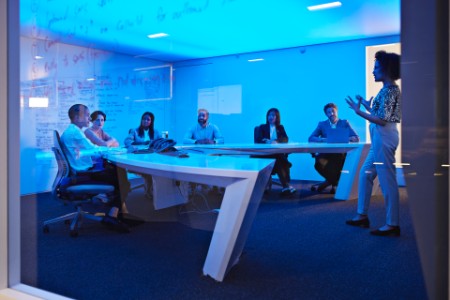
Chapter 1
Where to start?
Take these actions now to enable a successful workforce transformation
1. Invest in the right tooling; disparate spreadsheets are yesterday’s approach
The capability to plan and execute large-scale workforce change, at pace and over an extended period of implementation, is critically dependent on using a fit-for-purpose modelling and planning tools. Until recently, major workforce changes used to be planned and delivered on spreadsheets – often several, disjointed versions for different aspects and business units. There were risks of error, version control and even data loss.
Clients consistently ask if there is a better way: and there is. There are several tools available, and each has its strengths. For example, EY has developed the EY Organization Talent Hub (OTH). This is a single database of HR, finance, and planning information, and has cloud-based user modules that support users through the comprehensive process of strategic workforce planning, organization design, implementation, tracking and reporting.
Strategic workforce planning tools utilize powerful data ingestion, matching and cleaning capabilities that have been developed to address data gaps and disparities that naturally emerge in large organizations. Multiple data feeds can be set up from different systems (e.g., multiple separate HR systems from legacy or merging organizations, financial data, reward and payroll data, learning and capability data), using APIs or regular automated downloads to keep the data accurate and current.
As organizations look to technology for assistance in reshaping their organization design model, they must prioritize the associated impacts on employee experience. Technology-enabled hybrid work has transformed the work experience and has instigated seismic shifts with respect to expectations from employees. Flexibility is the new norm, but the implications of hybrid work run deeper, crossing into the arenas of Diversity, Equity and Inclusion (DEI) and purpose.
HR leaders must carefully monitor organization design changes to ensure the new models support experience gains made during the pandemic. According to the EY 2021 Work Reimagined Employee Survey2, 54% of employees are prepared to quit, if not offered the flexibility they desire. HR must ensure these gains are not erased or tossed aside during the redesign process.
2. Leverage a single virtual team for timeframes and capabilities
Moving forward, companies should create an extended, virtual team across the strategy, HR, and finance functions to integrate activity across the planning timeframes. Which function has the accountability for running the team is dependent on the company and other variables. The secret of success is to have clear accountability, teaming and interface arrangements in place and understood. It also helps if this extended planning team has access to a single planning environment – and single version of the data. The central “core” team can then provide views of the planning data and progress with implementation across the range of timeframes (e.g., five years to the here-and-now), providing consistent reporting and insights across the business. Detailed planning, for example, at the initiative or the transaction level, can be delegated to HR leadership in different geographies or functions, based on access controls that are set at the required level of scope.
3. Use data to turn your design authority into a control tower
Companies must have a degree of foresight and control the change. There are essentially two models: a central team designs and controls the rollout; or the center sets a series of guiderails and leaves the implementation to specific business units. Either way, there is a need for control at the center. We call this the “control tower” and it needs to have two functions: to control the design itself and confirm that the organization that was designed or intended was indeed delivered (the blueprint), with associated benefits; and to control the rollout, including governing the timeline for implementation and the support necessary to make the rollout happen (the road map).
There are the traditional models of the design authority to draw upon, which ultimately need to encompass design leadership, design governance and design assurance. To deliver on these capabilities, the control tower goes further by using data to add rigor, pace and accuracy to these capabilities. The control tower owns the baseline and must be able to report progress easily against it. It must be able to model the impact of various design principles, decisions and scenarios to assess which is the most valuable in terms of supporting evidence-based decision-making. It must be able to capture the design in a model that can be accessed and worked on by multiple parts of the business at the same time, supported by finance and HR leadership. It must be able to provide needed information to decision-makers, providing a single version of the truth, such as around progress, costs and benefits. This calls for a modern, cloud-based modelling and reporting capability.
4. Build links from strategy through to execution that provide value to strategy, HR, and finance
Companies need to have confidence that they can execute on design decisions moving forward. It’s not enough to have the perfect design down on paper: what’s critically important is the ability to drive from that design into execution of the necessary changes. Too often, teams responsible for designing and costing the new workforce design have other teams responsible for making the changes. Most often, the implementation just doesn’t happen as designed.
The proper approach is to drive the execution from the planning environment itself, which creates two advantages. First, by having a design linked to a transition or implementation plan in the modelling tool, the software will produce up-to-date outputs that enable better, more informed decision-making. This can help plan and schedule tasks that simply need to correct, like redeploying staff at the right time and to the right roles, or if necessary, scheduling and controlling the consultation process for any staff that need to be let go. An additional advantage is that by providing HR leadership and line managers with access to the tool, they can report back on progress and prevent rekeying of data on implementation progress.
Second, by tracking the progress of implementation in real-time, the control tower can track the realization of benefits that were promised. More importantly, should the situation change, for example because COVID-19 restrictions are being lifted at different rates than originally expected, the transition plan can be adjusted centrally and the timetable re-set immediately.

Chapter 2
Emerging trends
Leading companies are redesigning their organizations to capture growth
Far from easing back on making large-scale organizational changes during the pandemic, the evidence is that businesses have pressed ahead with strategic changes that were either already planned or will position them to capitalize on the rebound agenda.
EY recently analyzed a sample of 20 large, multinational companies and looked closely at the organizations changes they were making in the first half of 2021. We identified common threads and actions these leading organizations are taking:
- Evolving their structures so they are leaner and fitter: to drive margin and free up resources to focus on growth areas. For example, a large global financial services organization is continuing a drive to de-layer its European business, despite pausing a broader ambitious restructuring programme, and a digital consulting firm is delivering a major restructuring initiative to trim the senior-level work force, flatten structures and improve the speed of decision making.
- Organizing to drive customer centricity: including deepening capabilities for customer insight, investing in innovation and building deeper technology capabilities. Many large organizations with portfolios of products continue to focus on delivering a differentiated service to meet the needs of target customer groups and adopt organisational models to better support this.
- Extracting long-term value from acquisitions and further focusing on the value-creating core: Many companies we examined have not historically achieved the level of integration and value they expected from acquisitions. However, over the last year there has been further focus on bedding these in. For example, the digital consulting firm has been integrating acquisitions. One of the world’s largest telecommunications companies has been adjusting its portfolio in Central and South America, especially to focus on Brazil, and investing in new offerings such as cybersecurity and Spanish-language broadcasting.
- Building deeper technology- and digital-focused capabilities: and deploying these in a flexible way as demand changes. For example, the large global financial service organization continues to move towards digital channels (e.g. in North America) and almost every company in our study has a strategic focus on building out their technology-enabled products and services, with accompanying investments in underpinning skills and capabilities, often in specific incubator and accelerator arms.
- Driving growth through targeted investment in specific fast-growth regions or markets: either directly or with local joint venture partnerships. This is particularly common in financial services and life sciences, where for example: one organization is co-investing in a new health innovation hub to focus on diabetes as well as in France with expanded R&D capabilities and an innovation hub; and pharmaceutical is investing in women’s healthcare, vitamins and supplements.
Final thoughts and key take-aways
In some ways the pandemic brought forward the need to do things in a resilient way and reimagine the way all organizations worked, from technology, operating models and their people.
In 2021, EY conducted two surveys focused on employees and employer perspectives on workplace and workforce outcomes of the pandemic. In our, global Work Reimagined Employee and Employer Surveys, we found that 90% employees feel empowered to work flexibly as part of a global phenomenon. In fact, over half (54%) told us they would quit if not given the flexibility they needed. What’s even more interesting, is that ~80% of employers believe they will leverage hybrid work models, but only 40% of employers have communicated their hybrid, or flexible, plans to their workforce.
It’s safe to say, the genie is out of the bottle on hybrid work and it’s on the employers to set up a model that satisfies business requirements while reducing employee turnover, increasing retention, and improving the employee experience.
Summary
How can organizations create a workforce to be reckoned with? Put people at the top of their agenda, through strategic workforce planning, upskilling and reskilling, therefore creating long-term value for their stakeholders.

